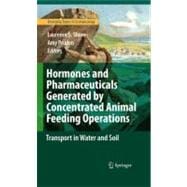
What is included with this book?
| Introduction | p. 1 |
| Steroid Hormones and Enzymes | p. 7 |
| Steroid Hormones Generated by CAFOs | p. 13 |
| Transport of Steroids in Surface Waters | p. 23 |
| Physiochemical Characterization of Steroid Hormones in Soil | p. 29 |
| Transport of Steroids in Soil Under Field Conditions | p. 37 |
| Tracking Sources of CAFO Pollution | p. 47 |
| Soil Ecology and Factors Affecting Biomass | p. 53 |
| Occurrence and Transport of Antibiotics from CAFOs | p. 63 |
| Antibiotic Resistance Associated with CAFOs | p. 71 |
| Effects of Steroid Hormones on Aquatic and Soil Organisms | p. 85 |
| Organic Compounds used in Aquaculture | p. 95 |
| Organic Compounds Used in Animal Husbandry | p. 115 |
| Environmental Impact and Risk of CAFOs | p. 125 |
| Management Approaches to Dealing with Pharmaceuticals and Hormones from CAFOs | p. 137 |
| Index | p. 143 |
| Table of Contents provided by Ingram. All Rights Reserved. |
The New copy of this book will include any supplemental materials advertised. Please check the title of the book to determine if it should include any access cards, study guides, lab manuals, CDs, etc.
The Used, Rental and eBook copies of this book are not guaranteed to include any supplemental materials. Typically, only the book itself is included. This is true even if the title states it includes any access cards, study guides, lab manuals, CDs, etc.